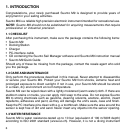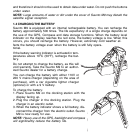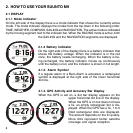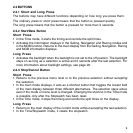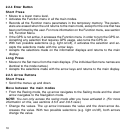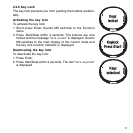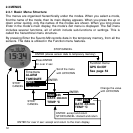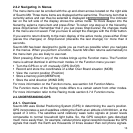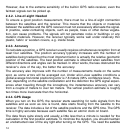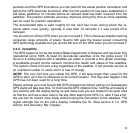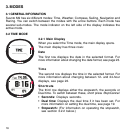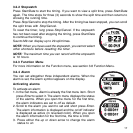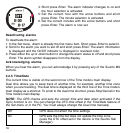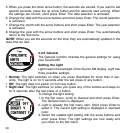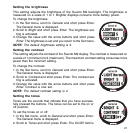14
However, due to the extreme sensitivity of the built-in GPS radio receiver, even the
faintest signals can be picked up.
2.4.2. Line-of-sight Needed
To ensure a good position measurement, there must be a line-of-sight connection
between the satellites and the receiver. This means that the objects or materials
between the satellites and the GPS receiver must not excessively attenuate the signal.
In practice, water-containing objects, such as people, trees or other dense vegeta-
tion, can cause problems. The signals will not penetrate rocks or buildings or any
metallic materials. However, the receiver typically works well under relatively thin
plastic, fabric or wooden covers, e.g. inside boats.
2.4.3. Accuracy
To calculate a position, a GPS receiver usually requires simultaneous reception from at
least four satellites. The position accuracy typically increases with the number of
satellites being tracked but the most important factor is actually the relative geometric
position of the satellites. The best position estimate is obtained when satellites from
different directions and angles can be tracked. In other words, the less obstructed the
receiver’s view of the sky, the better the accuracy.
The accuracy also improves with the number of measurements made on the same
spot, as some errors will be averaged out. Under all-in-view satellite conditions a
global average horizontal positioning error is 7.8 meters (95% confidence level). How-
ever, depending on the satellite constellation and the distortion the GPS signal experi-
ences when traveling through the ionosphere, the instantaneous accuracy can vary
from a couple of meters to over ten meters. The vertical position estimate is roughly
two times more inaccurate than the horizontal.
2.4.4. GPS Usage
When you turn on the GPS, the receiver starts searching for radio signals from the
satellites and as soon as one is found, data starts flowing from the satellite to the
receiver. The data includes a list of the satellite positions and the GPS time. The GPS
time is highly accurate because each satellite has an atomic clock on board.
The data flows quite slowly and usually a little less than a minute is needed for the
calculation of the first position estimate. To minimize the duration, you should maintain
an unobstructed view of the sky right after turning on the GPS. You need the satellite



